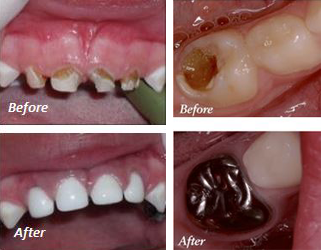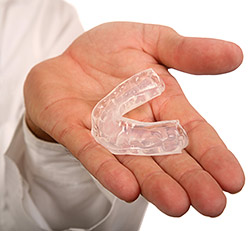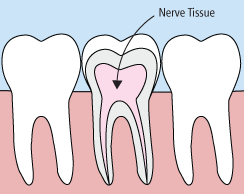Common Dental Procedures
in San Diego, CA
Topics on this page

Exams and Cleanings
Semi-annual exams are foundational for your child’s oral health. During your child’s regular exam, we will:
- Check for any problems that may not be seen or felt
- Look for cavities or other signs of tooth decay
- Inspect the teeth and gums for gingivitis and signs of periodontal disease
- Perform a thorough teeth cleaning
Each regular exam includes a detailed teeth cleaning, during which we will clean, polish, and rinse the teeth to remove any tartar and plaque that have built up on the tooth’s surface.
Visiting our office every six months gives you the chance to talk to the doctor about any questions you may have about your child’s oral health. Regular exams are offered by appointment only, so please contact our practice today to schedule your child’s next dental exam and teeth cleaning.
Bonding
 Bonding is a conservative way to repair slightly chipped, discolored, or crooked teeth. During dental bonding, a white filling is placed onto your child’s tooth to improve its appearance. The filling “bonds” with the tooth. Because it comes in a variety of tooth-colored shades, it closely matches the appearance of your child’s natural teeth.
Bonding is a conservative way to repair slightly chipped, discolored, or crooked teeth. During dental bonding, a white filling is placed onto your child’s tooth to improve its appearance. The filling “bonds” with the tooth. Because it comes in a variety of tooth-colored shades, it closely matches the appearance of your child’s natural teeth.
Tooth bonding can also be used for fillings instead of amalgam. Many patients prefer bonded fillings because the white color is much less noticeable than the silver amalgam. Bonding fillings can be used on front or back teeth, depending on the location and extent of tooth decay.
Bonding is less expensive than other cosmetic treatments and can usually be completed in one visit to our office. However, bonding can stain and is easier to break than other cosmetic treatments, such as porcelain veneers. If it does break or chip, tell your doctor. The bonding can generally be easily patched or repaired in one visit.
Crowns

Crowns are a restorative procedure for teeth that have extensive decay or damage that cannot be repaired with a filling. Just because your child’s baby teeth will eventually fall out doesn’t mean we don’t want to take great care of them. A crown covers the entire tooth to give strength and provide function until the permanent adult tooth comes in. There are two primary types of crowns for children.
Stainless Steel Crown (back teeth)
Stainless steel crowns are placed on a child’s back teeth, molars. The durability of stainless steel is ideal for the pressure back teeth experience from chewing.
Resin Crown (front teeth)
Resin crowns are created from tooth-colored material which makes them more esthetically pleasing and perfect for front teeth. Resin crowns are weaker than stainless steel crowns therefore they require following strict care instructions for providing the best results in durability and esthestics.
Extractions
 There are times when it is necessary to remove a tooth. Sometimes a baby tooth has misshapen or long roots that prevent it from falling out as it should, and the tooth must be removed to make way for the permanent tooth to erupt.
There are times when it is necessary to remove a tooth. Sometimes a baby tooth has misshapen or long roots that prevent it from falling out as it should, and the tooth must be removed to make way for the permanent tooth to erupt.
At other times, a tooth may have so much decay that it puts the surrounding teeth at risk, so the doctor may recommend its removal. Infection, orthodontic correction, or problems with a wisdom tooth can also require removal of a tooth.
When it is determined that a tooth needs to be removed, your child’s dentist may extract it during a regular checkup or may request another visit for this procedure. The root of each tooth is encased within the jawbone in a “tooth socket,” and the tooth is held in that socket by a ligament.
In order to extract a tooth, the dentist must expand the socket and separate the tooth from the ligament holding it in place. While this procedure is typically very quick, it is important to share with us any concerns or preferences for sedation.
Fillings
.jpg) Traditional dental restoratives, or fillings, may include gold, porcelain, or composite. Newer dental fillings include ceramic and plastic compounds that mimic the appearance of natural teeth. These compounds, often called composite resins, are typically used on the front teeth where a natural appearance is important.
Traditional dental restoratives, or fillings, may include gold, porcelain, or composite. Newer dental fillings include ceramic and plastic compounds that mimic the appearance of natural teeth. These compounds, often called composite resins, are typically used on the front teeth where a natural appearance is important.
There are two different kinds of fillings: direct and indirect. Direct fillings are placed into a prepared cavity during a single visit. Indirect fillings generally require two or more visits. These fillings include inlays, and veneers fabricated with ceramics or composites.
Fluoride
 Fluoride is effective in preventing cavities and tooth decay. It also prevents plaque from building up and hardening on the tooth’s surface. A fluoride treatment in our office takes just a few minutes.
Fluoride is effective in preventing cavities and tooth decay. It also prevents plaque from building up and hardening on the tooth’s surface. A fluoride treatment in our office takes just a few minutes.
After the treatment, your child may be asked not to rinse, eat, or drink for at least 30 minutes in order to allow the teeth to absorb the fluoride. Depending on your child’s oral health or the doctor’s recommendation, a fluoride treatment may be required every three, six, or 12 months.
Mouthguards
 Whether your child wears braces or not, protecting his or her smile while playing sports is essential. Mouthguards help protect the teeth and gums from injury. If your child participates in any kind of full-contact sport, the American Dental Association recommends that he or she wear a mouthguard.
Whether your child wears braces or not, protecting his or her smile while playing sports is essential. Mouthguards help protect the teeth and gums from injury. If your child participates in any kind of full-contact sport, the American Dental Association recommends that he or she wear a mouthguard.
Choosing the right mouthguard is essential. There are three basic types of mouthguards: the pre-made mouthguard, the “boil-and-bite” fitted mouthguard, and a custom-made mouthguard from the dentist. When you choose a mouthguard, be sure to pick one that is tear-resistant, comfortable and well-fitted for your mouth, easy to keep clean, and does not prevent your child from breathing properly.
Dr. Job or Dr. Josh can show your son or daughter how to wear a mouthguard properly and how to choose the right mouthguard to protect his or her smile.
Nightguards
 If your child often wakes up with jaw pain, earaches, or headaches, or you see your child clenching or grinding his or her teeth, your child may have a common condition called “bruxism.” Many people do not even know they grind their teeth, because it often occurs during sleep. If not corrected, bruxism can lead to broken teeth, cracked teeth, or even tooth loss.
If your child often wakes up with jaw pain, earaches, or headaches, or you see your child clenching or grinding his or her teeth, your child may have a common condition called “bruxism.” Many people do not even know they grind their teeth, because it often occurs during sleep. If not corrected, bruxism can lead to broken teeth, cracked teeth, or even tooth loss.
There is an easy, non-invasive treatment for bruxism: nightguards. Nightguards are an easy way to prevent the wear and damage that teeth-grinding causes over time. Custom-made by a dentist from soft material to fit the teeth, a nightguard is inserted over your child’s top or bottom arch and prevents contact with the opposing teeth.
Pediatric Root Canal Therapy (Pulpotomy or Pulpectomy)
 In the past, if your child had a tooth with an infection of the tooth’s nerve tissue, called pulp, he or she would probably need that tooth removed. Today, with a special dental procedure, called a pulpotomy or pulpectomy, your child’s tooth can be saved.
In the past, if your child had a tooth with an infection of the tooth’s nerve tissue, called pulp, he or she would probably need that tooth removed. Today, with a special dental procedure, called a pulpotomy or pulpectomy, your child’s tooth can be saved.
When a tooth is cracked or has a deep cavity, bacteria can enter the pulp tissue and germs can cause an infection inside the tooth. If left untreated, an abscess may form causing swelling and pain. The pain may subside temporarily with pain medication and antibiotics but will return if not treated. An untreated infection can not only injure your child’s jawbones, but can get into the bloodstream which is detrimental to his or her overall health.
During treatment, Dr. Job or Dr. Josh removes the infected pulp tissue in the crown of the tooth for a pulpotomy or into the root(s) for a pulpectomy. The interior of the tooth is cleaned and sealed. A medicine is placed to calm the nerve and prevent bacterial growth.
A crown is then placed over the tooth to protect it. As long as your child continues to care for his or her teeth and gums with regular brushing, flossing, and checkups, the restored tooth can last until the permanent adult tooth comes in.
Sealants
 Sometimes brushing is not enough, especially when it comes to those hard-to-reach spots in your child’s mouth. It is difficult for a toothbrush to get between the small cracks and grooves on your child’s teeth. If left alone, those tiny areas can develop tooth decay. Sealants give your child’s teeth extra protection against decay and help prevent cavities.
Sometimes brushing is not enough, especially when it comes to those hard-to-reach spots in your child’s mouth. It is difficult for a toothbrush to get between the small cracks and grooves on your child’s teeth. If left alone, those tiny areas can develop tooth decay. Sealants give your child’s teeth extra protection against decay and help prevent cavities.
Dental sealants are plastic resins that bond and harden in the deep grooves on the surface of your child’s tooth. When a tooth is sealed, the tiny grooves become smooth and are less likely to harbor plaque. With sealants, brushing your child’s teeth becomes easier and more effective against tooth decay.
Sealants are typically applied to children’s teeth as a preventive measure against tooth decay after the permanent teeth have erupted. It is more common to seal “permanent” teeth rather than “baby” teeth, but every patient has unique needs, and Dr. Job or Dr. Josh will recommend sealants on a case-by-case basis.
Sealants last from three to five years, but it is fairly common to see adults with sealants still intact from their childhood. A dental sealant only provides protection when it is fully intact, so if your child’s sealants come off, let us know, and schedule an appointment for your child’s teeth to be re-sealed.


